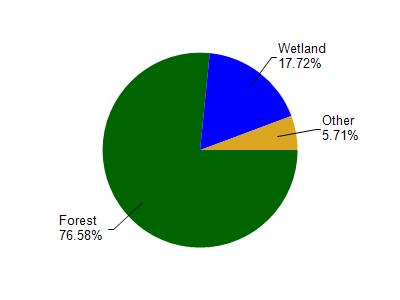Florence
No
No
No
Fish and Aquatic Life
Overview
Fisher Lake, in the Brule River Watershed, is a 50.42 acre lake that falls in Florence County. This lake is managed for fishing and swimming and is currently not considered impaired.
Date 2011
Author Aquatic Biologist
Historical Description
A medium hard water drainage lake having slightly acid, medium brown water of moderate transparency. Littoral materials consist of sand (75 percent), gravel (24 percent) and rubble. The shoreline is predominantly upland (95 percent) of which 50 percent is cleared, 40 percent in mixed hardwoods and 10 percent coniferous. The balance of the shoreline is wetland of the shrub-meadow and swamp hardwood types. The outlet stream, Fisher Creek, is tributary to the Brule River. Fish species inhabiting the lake are northern pike, largemouth bass, perch, bluegill, brook trout, carp and forage species. This is the only lake in Florence County known to have a carp population. Puddle ducks and diving ducks make limited use of this lake. The Town of Florence provides a public access site with parking on the south side of the lake. Six dwellings, one convalescent home, and the county highway garage are located on the shoreline. The Village of Florence is located on the north shore. Source: 1971, Surface Water Resources of Florence County Fisher Lake, T40N, R18E, Section 28 Surface Acres-54.1, Secchi Disc-5 feet, Maximum Depth-49 feet
Date 1971
Author Surface Water Inventory Of Wisconsin
Condition
Wisconsin has over 84,000 miles of streams, 15,000 lakes and milllions of acres of wetlands. Assessing the condition of this vast amount of water is challenging. The state's water monitoring program uses a media-based, cross-program approach to analyze water condition. An updated monitoring strategy (2015-2020) is now available. Compliance with Clean Water Act fishable, swimmable standards are located in the Executive Summary of Water Condition in 2018. See also the 'monitoring and projects' tab.
Reports
Management Goals
Wisconsin's Water Quality Standards provide qualitative and quantitative goals for waters that are protective of Fishable, Swimmable conditions [Learn more]. Waters that do not meet water quality standards are considered impaired and restoration actions are planned and carried out until the water is once again fishable and swimmable
Management goals can include creation or implementation of a Total Maximum Daily Load analysis, a Nine Key Element Plan, or other restoration work, education and outreach and more. If specific recommendations exist for this water, they will be displayed below online.
Monitoring
Monitoring the condition of a river, stream, or lake includes gathering physical, chemical, biological, and habitat data. Comprehensive studies often gather all these parameters in great detail, while lighter assessment events will involve sampling physical, chemical and biological data such as macroinvertebrates. Aquatic macroinvertebrates and fish communities integrate watershed or catchment condition, providing great insight into overall ecosystem health. Chemical and habitat parameters tell researchers more about human induced problems including contaminated runoff, point source dischargers, or habitat issues that foster or limit the potential of aquatic communities to thrive in a given area. Wisconsin's Water Monitoring Strategy was recenty updated.
Grants and Management Projects
| Project Name (Click for Details) | Year Started |
|---|
|
|
Monitoring Projects
| WBIC | Official Waterbody Name | Station ID | Station Name | Earliest Fieldwork Date | Latest Fieldwork Date | View Station | View Data |
|---|
| 704200 | Fisher Lake | 10002433 | Fisher Lake | 4/23/1900 | 7/15/2022 | Map | Data |
| 704200 | Fisher Lake | 193004 | Fisher Lake - Deepest Area | 8/5/2008 | 8/10/2023 | Map | Data |
| 704200 | Fisher Lake | 10019042 | Fisher Lake -- Access | 6/14/2009 | 4/26/2023 | Map | Data |
|

Watershed Characteristics
Fisher Lake is located in the Brule River watershed which is 194.73 mi². Land use in the watershed is primarily forest (76.50%), wetland (17.70%) and a mix of grassland (2.90%) and other uses (2.80%). This watershed has 192.50 stream miles, 2,169.69 lake acres and 13,322.90 wetland acres.
Nonpoint Source Characteristics
This watershed is ranked Low for runoff impacts on streams, Not Ranked for runoff impacts on lakes and Low for runoff impacts on groundwater and therefore has an overall rank of Low. This value can be used in ranking the watershed or individual waterbodies for grant funding under state and county programs.However, all waters are affected by diffuse pollutant sources regardless of initial water quality. Applications for specific runoff projects under state or county grant programs may be pursued. For more information, go to surface water program grants.